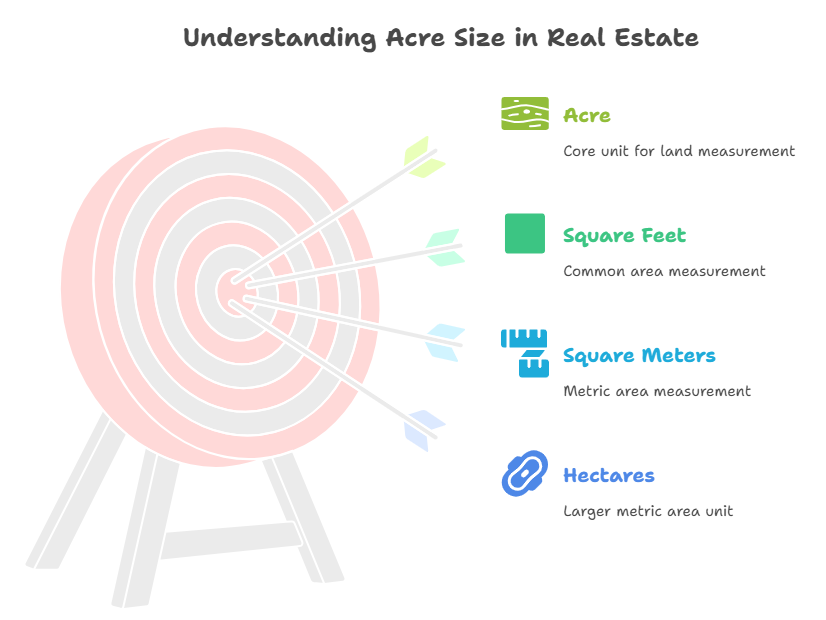Quick Answer: How Big is an Acre of Land?
“How Big is an Acre of Land?” is a question many people ask when trying to visualize property size. Simply put, one acre equals 43,560 square feet. To make that easier to picture, think of a football field (without the end zones) — that’s just about the size of an acre. It can also be compared to roughly 16 tennis courts lined up or about 75% of a soccer field. The exact shape of an acre can vary, but the area always remains the same.
Whether used for farming, building, or just measuring space, understanding “How Big is an Acre of Land?” helps you imagine how much room you truly have. It’s bigger than you think, but smaller than you expect!
Now let’s dive deeper.

What is an Acre?
An acre is a unit of area commonly used in the United States to measure large parcels of land. It is defined as:
- 43,560 square feet
- Roughly 4,047 square meters
- Equivalent to 0.4047 hectares
While this might sound very technical, it’s easier to understand by putting it into real-world comparisons.
Visualizing an Acre of Land
Because most people don’t regularly deal in square feet or hectares, visual comparisons help put things into perspective. Here are a few ways to picture an acre:
- A Football Field: An American football field (excluding the end zones) is about 48,000 square feet, which makes it slightly larger than an acre. So imagine just under a full football field, and you’re close to the size of one acre.
- Tennis Courts: About 16 tennis courts can fit into a single acre.
- Parking Spaces: A standard parking space is around 180 square feet, so you could fit about 240 parking spaces in an acre of land.
- Homes: Depending on home size and layout, an acre can fit four to five average-sized suburban homes with yards.
These comparisons give a tangible sense of just how much space an acre provides, which is crucial when determining land use.
Why Acreage Matters in Real Estate?
Acreage plays a significant role in determining a property’s value and potential. Here’s how:
1. Zoning and Development Potential
Zoning laws vary by county and municipality in Texas, but the amount of land you own dictates what you can legally build. For example:
- One acre may allow for a single-family residence with a large yard.
- Multiple acres could be zoned for agricultural use, multi-family housing, or even commercial development.
Understanding the exact acreage helps buyers and developers determine whether a piece of land suits their needs.
2. Utility and Access
Access to utilities (water, electricity, sewer) is often more manageable on smaller plots. Larger acreages, especially in rural Texas, may require investment in infrastructure. If you’re selling land without utilities, knowing its exact size can help set expectations for buyers.
3. Pricing Strategy
Land is typically priced per acre. In Texas, prices can range from $5,000 per acre in remote rural areas to over $100,000 per acre in growing suburbs or cities. Knowing how many acres you own and what that land offers can help you and your agent determine an accurate listing price.
How Acreage Affects Buyers and Sellers?
When dealing with acreage, both buyers and sellers must perform due diligence:
- Buyers should check for encroachments, easements, flood zones, and development restrictions. Buying a 10-acre property that can’t be subdivided or built on might not suit everyone’s goals.
- Sellers must be prepared with property surveys, title work, and knowledge of any restrictions or liens. Larger land sales often involve more complex negotiations than selling a home on a standard residential lot.
This is where cash buyers often come in.
The Role of Cash Buyers in Large Land Transactions
Selling land—especially multiple acres—can sometimes take months if traditional financing or bank approvals are involved. Cash buyers remove that delay.
Here’s why cash buyers are helpful when selling acreage:
- Fast Transactions: Cash sales typically close in under 30 days, often much faster.
- As-Is Sales: Cash buyers often buy land in its current condition, with fewer contingencies.
- No Commissions: Many cash buyers purchase directly from owners, avoiding real estate commissions.
- No Financing Failures: Without mortgages, there’s no risk of a deal falling through due to loan denial.
This is especially relevant in Texas, where large tracts of undeveloped land are common, and sellers want fast, hassle-free closings.
Final Thoughts
Understanding the true size of an acre—and how it compares to familiar landmarks—empowers both buyers and sellers to make informed decisions. Whether you’re sitting on a 1-acre parcel or managing 100 acres of farmland, knowing the value, utility, and layout of your land is critical.
And when it comes time to sell, partnering with professionals who understand the local land market makes all the difference. If you want to skip the headaches of listing, staging, and waiting months for the right offer, consider working with trusted cash buyers in Texas.
Call us anytime at 713-561-5162 or connect with us on our website and we’ll lay out all of your options for your specific situation.
